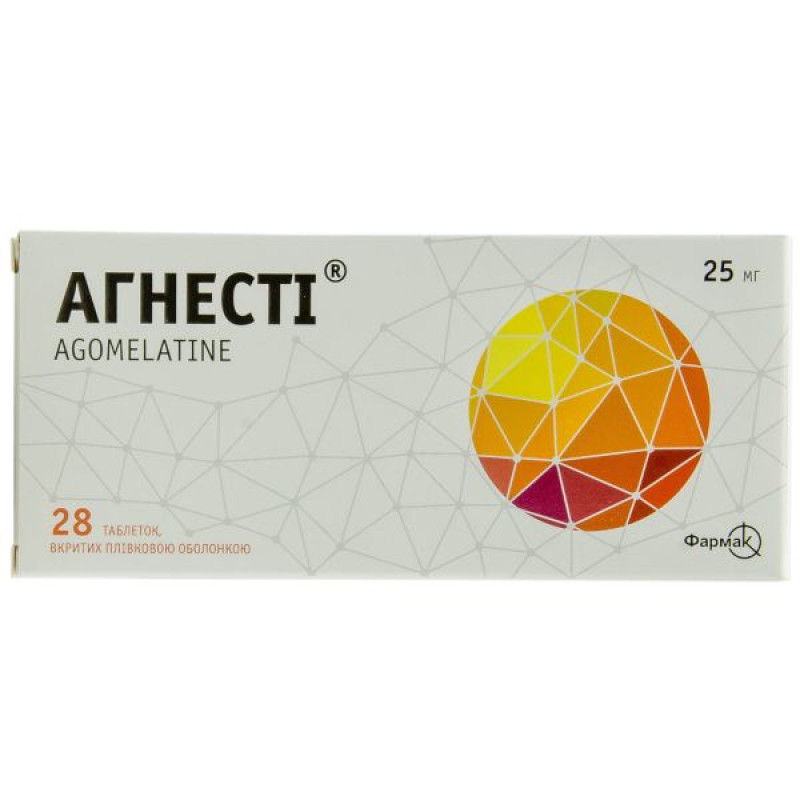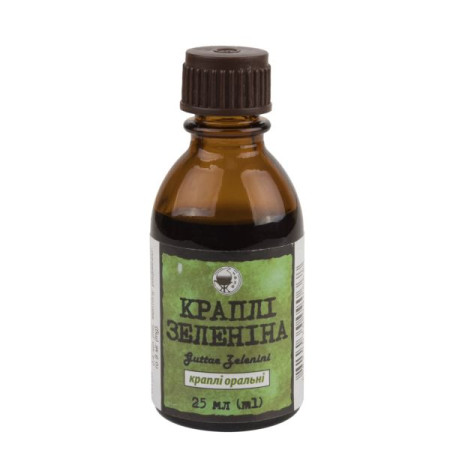Agnesti tablets 25 mg No. 28

Instructions for Agnesti tablets 25 mg No. 28
Composition
active ingredient: agomelatine;
1 tablet contains cocrystal of agomelatine and citric acid – 44.739 mg (in terms of agomelatine – 25 mg);
Excipients: silicified microcrystalline cellulose, mannitol (E 421), povidone 30, colloidal anhydrous silica, crospovidone (type A), sodium stearyl fumarate, magnesium stearate, stearic acid 50, hypromellose (hydroxypropyl methylcellulose) 2910/5, polyethylene glycol (macrogol) 6000, titanium dioxide (E 171), talc, yellow iron oxide (E 172).
Dosage form
Film-coated tablets.
Main physicochemical properties: yellow, oblong, biconvex tablets, film-coated.
Pharmacotherapeutic group
Psychoanaleptics. Other antidepressants. ATX code N06A X22.
Pharmacological properties
Pharmacodynamics
Mechanism of action
Agomelatine is a melatoninergic agonist at MT1 and MT2 receptors and an antagonist at 5-HT2c receptors. Receptor binding studies have shown that agomelatine does not affect monoamine uptake and has no affinity for α- and β-adrenergic, histaminergic, cholinergic, dopaminergic, or benzodiazepine receptors.
In experimental studies in animals with circadian rhythm disorders, agomelatine has been shown to resynchronize circadian rhythms.
Agomelatine increases the release of dopamine and noradrenaline, especially in the frontal cortex, and does not affect extracellular serotonin levels.
Pharmacodynamic effects
In experimental animal studies, agomelatine demonstrated an antidepressant effect in validated models of depression (test of hopelessness, despair, chronic mild stress), as well as in models with desynchronization of circadian rhythms and models associated with stress and anxiety.
In humans, agomelatine resynchronizes circadian rhythms, restores sleep phasicity, causes a decrease in body temperature, and promotes melatonin secretion.
Clinical efficacy and safety
The efficacy and safety of agomelatine in the treatment of major depressive episodes were studied in a clinical program involving 7,900 patients.
In six short-term, double-blind, placebo-controlled studies evaluating the efficacy of agomelatine in the treatment of major depressive episodes in adult patients, agomelatine at doses of 25-50 mg at the end of treatment (for 6-8 weeks) demonstrated statistically significant efficacy compared to placebo. The results of the assessment using the HAMD-17 scale (Hamilton Depression Scale) showed changes in the primary endpoint from baseline.
The efficacy of agomelatine was also demonstrated in patients with more severe depression (baseline HAMD total score ≥ 25) in all positive placebo-controlled studies.
Response rates to treatment with agomelatine were statistically significantly higher compared to placebo.
Six of the seven studies investigating the efficacy of agomelatine in heterogeneous populations of adult patients with depression demonstrated superior (2 studies) or non-inferiority (4 studies) efficacy of agomelatine compared with selective serotonin reuptake inhibitors/serotonin-norepinephrine reuptake inhibitors (SSRIs/SNRIs) (sertraline, escitalopram, fluoxetine, venlafaxine or duloxetine). Antidepressant effect was assessed using the HAMD-17 scale as either a primary or secondary endpoint.
The long-term antidepressant efficacy of agomelatine was demonstrated in a relapse prevention study. Agomelatine 25–50 mg/day was statistically superior to placebo in the primary endpoint of prevention of depressive relapse, as measured by time to relapse (p=0.0001). The relapse rate during the 6-month double-blind follow-up period was 22% and 47% in the agomelatine and placebo groups, respectively.
The drug does not affect daytime alertness and memory in healthy volunteers. In depressed patients, treatment with agomelatine prolonged the slow-wave sleep phase without affecting the phase or latency of REM sleep. Agomelatine at a dose of 25 mg also reduces the time to sleep onset (facilitates falling asleep) and to reach a state with a minimum heart rate. According to patients, from the first week of treatment, falling asleep and sleep quality significantly improved without disturbing daytime activity.
A pooled analysis of studies using the Arizona Sexual Experience Scale (ASEX) demonstrated that agomelatine was not associated with sexual dysfunction. In healthy volunteers, agomelatine preserved sexual function compared with paroxetine.
In clinical studies, agomelatine had no effect on heart rate and blood pressure.
Agomelatine is not addictive, as determined in studies involving healthy volunteers based on the results of tests using a special visual analog scale or the 49-question ARCI (Addiction Research Center Inventory) questionnaire.
A placebo-controlled study of agomelatine 25–50 mg/day for 8 weeks in elderly patients with depression (≥ 65 years, N = 222, 151 of whom received agomelatine) demonstrated a statistically significant difference of 2.67 points on the HAMD total score (primary endpoint). The response rate was positive for agomelatine. In the group of patients ≥ 75 years of age (N = 69, 48 of whom received agomelatine), no significant improvement was observed. The tolerability of agomelatine in elderly patients and in younger adults was similar.
A specific 3-week controlled study was conducted in patients with major depressive disorder who had not achieved significant improvement with paroxetine (an SSRI) or venlafaxine (an SNRI). When these patients were switched to agomelatine, whether the previous treatment was stopped abruptly or gradually, withdrawal symptoms occurred. These symptoms may be mistaken for a lack of early effect of agomelatine.
The percentage of patients with at least one withdrawal symptom within 1 week of stopping SSRI/SNRI antidepressants was lower in the long-term taper group (gradual discontinuation of previous antidepressants over 2 weeks) than in the short-term taper group (gradual discontinuation of previous antidepressants over 1 week) and the abrupt treatment change group (abrupt discontinuation): 56.1%, 62.6%, and 79.8%, respectively.
Pharmacokinetics
Absorption and bioavailability
Agomelatine is rapidly and well (≥ 80%) absorbed after oral administration. Absolute bioavailability is low (< 5% when administered orally at therapeutic doses), with significant interindividual variability. Bioavailability is higher in women than in men. Bioavailability is increased by oral contraceptives and decreased in smokers. Peak plasma concentrations are reached within 1–2 hours.
When used in therapeutic doses, the concentration of agomelatine increases proportionally with increasing dose. When used in higher doses, a saturation effect occurs with the first dose.
Food intake (regular or high-fat) does not affect bioavailability or the extent of absorption.
Variability increases with high-fat meals.
Distribution
The volume of distribution at steady state is about 35 L, plasma protein binding is 95% regardless of concentration and does not change with age or in patients with renal impairment, but the concentration of the free fraction is doubled in patients with hepatic impairment.
Biotransformation
After administration, agomelatine is rapidly metabolized, mainly by the hepatic enzyme CYP1A2; CYP2C9 and CYP2C19 are also involved in metabolism, but their contribution is insignificant. The main metabolites, hydroxylated and demethylated agomelatine, are inactive and are rapidly conjugated and excreted in the urine.
Breeding
Elimination is rapid, with an average plasma half-life of 1–2 hours. Clearance is high (approximately 1.1 ml/min) and is predominantly metabolic. Excreted mainly in the urine (80%) as metabolites, while the amount of unchanged active substance excreted in the urine is negligible. Pharmacokinetics do not change after repeated administration.
Patients with renal impairment
No relevant changes in agomelatine pharmacokinetic parameters were observed in patients with severe renal impairment (n = 8, single dose of 25 mg), but Agnesti® should be prescribed with caution to patients with severe or moderate renal impairment due to the limited clinical data on the use of agomelatine in this patient group (see section “Method of administration and dosage”).
Patients with hepatic impairment
A special study in patients with cirrhosis of the liver, chronic liver dysfunction of mild or moderate degree (types A and B according to the Child-Pugh classification) demonstrated an increase (70- and 140-fold, respectively) in the concentration of agomelatine administered at a dose of 25 mg, compared with that in volunteers with appropriate parameters (age, body weight and presence/absence of smoking habit) without impaired liver function (see sections "Method of administration and dosage", "Contraindications" and "Special instructions for use").
Elderly patients
A pharmacokinetic study in elderly patients (≥ 65 years) showed that when using the drug at a dose of 25 mg, the mean AUC and Cmax values were approximately 4 and 13 times higher in patients ≥ 75 years of age compared to those in patients < 75 years of age. It is not possible to assess the pharmacokinetics of agomelatine at a dose of 50 mg in this population due to insufficient data. Elderly patients do not require dose adjustment.
Ethnic groups
There are no data on the pharmacokinetics of agomelatine depending on race.
Treatment of major depressive episodes in adults.
Contraindication
Hypersensitivity to the active substance or any excipient of the medicinal product;
impaired liver function (cirrhosis or active liver disease) or increased transaminase levels more than 3 times the upper limit of normal (see sections "Method of administration and dosage" and "Special precautions for use");
use in combination with potent CYP1A2 inhibitors (fluvoxamine, ciprofloxacin) (see section "Interaction with other medicinal products and other types of interactions").
Interaction with other medicinal products and other types of interactions
Possible interactions of agomelatine
Agomelatine is metabolized primarily by cytochromes P450 1A2 (CYP1A2) (90%) and CYP2C9/19 (10%). Medicinal products that interact with these isoenzymes may reduce or increase the bioavailability of agomelatine.
Fluvoxamine, a potent CYP1A2 inhibitor and a moderate CYP2C9 inhibitor, significantly inhibits the metabolism of agomelatine, resulting in a 60-fold (range 12-412) increase in agomelatine concentrations. Therefore, concomitant use of Agnesti® with potent CYP1A2 inhibitors (fluvoxamine, ciprofloxacin) is contraindicated.
The combination of agomelatine with estrogens (moderate CYP1A2 inhibitors) leads to a several-fold increase in agomelatine concentrations. Although no dangerous symptoms were observed in 800 patients when agomelatine was used concomitantly with estrogens, caution should be exercised when prescribing agomelatine with other moderate CYP1A2 inhibitors (propranolol, enoxacin) until more experience is gained with the combination (see section 4.4).
Rifampicin, an inducer of all three cytochromes involved in agomelatine metabolism, may reduce the bioavailability of agomelatine.
Smoking stimulates CYP1A2 induction and reduces agomelatine bioavailability, especially in heavy smokers (≥ 15 cigarettes/day) (see section "Pharmacokinetics").
The ability of agomelatine to affect other medicines
In vivo, agomelatine does not activate CYP450 isoenzymes. Agomelatine does not inhibit CYP1A2 in vivo or other CYP450 enzymes in vitro. As a result, it does not affect the concentration of drugs metabolized by CYP450.
Drugs with a high degree of binding to blood plasma proteins
Agomelatine does not affect the concentration in the blood of the free fraction of substances with a high degree of binding to blood plasma proteins and vice versa.
Other medicines
In phase I clinical studies in the target patient population, no data were obtained on pharmacokinetic and pharmacodynamic interactions with drugs that can be administered concomitantly with agomelatine: benzodiazepines, lithium, paroxetine, fluconazole and theophylline.
Alcohol
It is not recommended to drink alcohol during treatment with Agnesti®.
Electroconvulsive therapy (ECT)
There is no experience with the use of agomelatine concomitantly with ECT. Animal studies have not shown that agomelatine increases seizure susceptibility. Therefore, it is unlikely that ECT in combination with Agnesti® will lead to any clinically significant complications.
Application features
Liver function monitoring
In the post-marketing setting, patients have been reported to experience hepatic dysfunction, including hepatic failure (isolated cases with fatal outcome or requiring liver transplantation have been reported in patients with risk factors for hepatic dysfunction), elevations of hepatic enzymes >10 times the upper limit of normal, hepatitis and jaundice (see section 4.8). Most of the events occurred during the first months of treatment. Liver damage is predominantly hepatocellular in nature and serum transaminases return to normal upon discontinuation of agomelatine.
Agnesti® should be prescribed with caution and all patients should be closely monitored during the treatment period, especially in the presence of risk factors for liver dysfunction or in the case of concomitant use of medicinal products that may cause liver dysfunction.
Before starting treatment
Patients with risk factors for liver dysfunction such as obesity/overweight/non-alcoholic fatty liver disease, diabetes mellitus, alcohol-related disorders, patients taking concomitant medications that may cause liver dysfunction should be treated with Agnesti® only after careful assessment of the benefits and risks of use.
All patients should have liver function tests performed before starting treatment. Patients with baseline alanine aminotransferase (ALT) and/or aspartate aminotransferase (AST) >3 times the upper limit of normal should not be started on treatment (see Contraindications). Agnesti® should be used with caution in patients with elevated transaminases prior to starting treatment (provided that the transaminases are not more than 3 times the upper limit of normal).
Before treatment; after treatment: approximately 3 weeks; approximately 6 weeks (at the end of the acute phase); approximately 12 weeks and 24 weeks (at the end of the maintenance phase); and subsequently if clinically indicated.
When the dose is increased, liver tests should be performed again at the same frequency as at the beginning of treatment.
Any patient who develops and is found to have elevated plasma transaminases should have a repeat liver function test within 48 hours.
During the treatment period
The use of Agnesti® should be discontinued immediately if:
The patient has developed symptoms of potential liver dysfunction (such as dark urine, light-colored stools, yellowing of the skin/eyes, right upper abdominal pain, new onset of unexplained prolonged fatigue); serum transaminase levels are 3 times the upper limit of normal.
After discontinuation of Agnesti®, liver tests should be repeated until serum transaminase levels return to normal.
People aged 75 and over
The effect of agomelatine in patients ≥ 75 years of age has not been proven, therefore agomelatine should not be used in patients in this age group (see sections “Method of administration and dosage” and “Pharmacodynamics”).
Elderly patients with dementia
Agnesti® should not be used to treat major depressive episodes in elderly patients with dementia, as the safety and efficacy of agomelatine in this patient population have not been established.
Bipolar disorder/mania/hypomania
Agnesti® should be used with caution in patients with a history of bipolar disorder, mania or hypomania. The drug should be discontinued if the patient develops manic symptoms (see section 4.8).
Suicide/suicidal thoughts
Depression is associated with an increased risk of suicidal thoughts, self-harm and suicide (suicidality). This risk persists until clinically significant remission is achieved. As the patient's condition may not improve during the first few weeks or more of treatment, the patient should be closely monitored until improvement occurs. General clinical experience suggests that the risk of suicide may be increased in the early stages of improvement.
Patients with a history of suicidal behaviour, as well as patients who show a high level of suicidal ideation prior to initiation of treatment, are at increased risk of suicidal thoughts or suicide attempts and should receive careful monitoring during treatment. A meta-analysis of placebo-controlled clinical trials of antidepressants in adult patients with psychiatric disorders showed an increased risk of suicidal behaviour with antidepressants compared with placebo in a group of patients under 25 years of age.
During treatment, especially in the early stages and after dose changes, patients, particularly those at high risk, should be closely monitored. Patients (and caregivers of patients) should be warned to monitor for any signs of clinical worsening, suicidal behaviour or thoughts, and unusual changes in behaviour and to seek medical advice immediately if these symptoms present.
Use in combination with CYP1A2 inhibitors (see sections “Contraindications” and “Interaction with other medicinal products and other types of interactions”)
Agnesti® should be administered with caution in combination with moderate CYP1A2 inhibitors (propranolol, enoxacin), which may lead to increased agomelatine concentrations.
Ability to influence reaction speed when driving vehicles or other mechanisms
No studies on the effects of agomelatine on the ability to drive or use machines have been conducted. However, given that dizziness and drowsiness are common side effects of the drug, patients should exercise caution when driving or operating machinery.
Use during pregnancy or breastfeeding
Pregnancy
It is preferable to avoid the use of Agnesti® during pregnancy. There are no or limited amount of data (less than 300 exposures) from the use of agomelatine in pregnant women. Animal studies do not indicate direct or indirect harmful effects of agomelatine on pregnancy, embryonal/fetal development, parturition or postnatal development.
Breast-feeding
It is not known whether agomelatine/metabolites are excreted in human milk. Available pharmacodynamic/toxicological data from animal studies have shown that agomelatine/metabolites are excreted in human milk. A risk to the newborn/infant cannot be excluded. A decision must be made whether to discontinue breast-feeding or to discontinue/abstain from Agnesti® therapy taking into account the benefit of breast-feeding for the child and the benefit of therapy for the woman.
Fertility
Animal reproduction studies have shown no effect of agomelatine on fertility.
Method of administration and doses
Method of application
For oral use.
Dosage
The recommended dose is 25 mg once daily, at bedtime.
If 2 weeks after the start of therapy, the clinical improvement is insufficient, the dose can be increased to 50 mg once a day, i.e. 2 tablets of 25 mg, which must be taken at the same time before bedtime.
When deciding to increase the dose, the increased risk of transaminase elevations should be taken into account. Dose increases to 50 mg should be made on an individual basis for each patient after assessing the benefit/risk ratio with mandatory liver function tests.
All patients should have liver function tests performed before starting treatment. Treatment should not be initiated if transaminase levels exceed 3 times the upper limit of normal (see sections 4.3 and 4.4).
Transaminase levels should be monitored periodically during treatment: approximately after 3 weeks, 6 weeks (end of acute phase), 12 weeks and 24 weeks (end of maintenance phase) and thereafter as clinically indicated (see section 4.4). Treatment should be discontinued if transaminase levels exceed three times the upper limit of normal (see sections 4.4 and 4.4).
When the dose is increased, liver tests should be performed again at the same frequency as at the beginning of treatment.
Duration of treatment
Patients with depression should be treated for at least 6 months to ensure that their symptoms resolve.
Switching from antidepressant therapy with selective serotonin reuptake inhibitors/serotonin norepinephrine reuptake inhibitors (SSRIs/SNRIs) to agomelatine
Patients may experience withdrawal symptoms after discontinuation of SSRI/SNRI antidepressants. To avoid these symptoms, the patient should follow the discontinuation recommendations in the patient's prescribing information. Agomelatine therapy may be initiated immediately following a dose reduction of the antidepressant (see section 5.2).
Discontinuation of treatment
If a decision is made to discontinue treatment, there is no need to gradually reduce the dose.
Special patient groups
Elderly patients
The safety and efficacy of agomelatine (25-50 mg/day) have been demonstrated in elderly patients with depression (< 75 years). No reliable results have been obtained in patients ≥ 75 years of age. Therefore, agomelatine should not be used in patients in this age group (see sections 4.4 and 5.2). There is no need for dose adjustment based on age (see section 5.2).
Patients with renal impairment
No relevant changes in agomelatine pharmacokinetic parameters were observed in patients with severe renal impairment. However, clinical data on the use of agomelatine in patients with depression and severe or moderate renal impairment are limited. Therefore, Agnesti® should be prescribed with caution in such patients.
Patients with hepatic impairment
The use of Agnesti® is contraindicated in patients with impaired liver function (see sections “Contraindications”, “Special instructions for use” and “Pharmacokinetics”)
Children
Agnesti® is not recommended for the treatment of depression in children, as the safety and efficacy of agomelatine have not been established in this patient group. Data are not available. In clinical trials in children and adolescents, suicidal behaviour (suicidal attempts and suicidal thoughts) and hostility (predominantly aggression, oppositional behaviour and anger) were observed more frequently with other antidepressants compared to patients taking placebo.
Overdose
Symptoms
There is limited data on cases of agomelatine overdose. Epigastric pain, drowsiness, fatigue, agitation, anxiety, tension, dizziness, cyanosis or malaise have been reported in cases of agomelatine overdose. There was 1 case of 2450 mg of agomelatine taken and recovery occurred spontaneously without cardiovascular or biological abnormalities.
Treatment
There are no specific antidotes for agomelatine. Treatment of overdose should consist of symptomatic therapy and routine observation of the patient. Medical observation in a specialized institution is recommended.
Adverse reactions
Agomelatine has been used in clinical trials in over 8,000 patients with depression. Adverse reactions usually occurred within the first 2 weeks of treatment and were mild to moderate in intensity. The most common adverse reactions were headache, nausea and dizziness. These adverse reactions were usually transient and did not usually lead to discontinuation of therapy.
The table below contains adverse reactions identified during placebo-controlled clinical trials and trials using active control.
Adverse reactions are listed below with the following frequency: very common (≥ 1/10); common (≥ 1/100 to < 1/10); uncommon (≥ 1/1,000 to < 1/100); rare (≥ 1/10,000 to < 1/1,000); very rare (< 1/10,000); frequency unknown (cannot be estimated from the available data). The frequency has not been adjusted for the placebo group.
| Classification by organ systems | Frequency | Adverse reaction |
| From the psyche | Often | Anxiety Unusual dreams* |
| Infrequently | Suicidal thoughts or behavior (see section "Special warnings and precautions for use") Agitation and related symptoms* (such as irritability and restlessness) Aggressiveness* Terrible dreams* Mania/hypomania*. These symptoms may be due to the underlying disease (see section "Special warnings and precautions for use") Confusion* | |
| Rarely | Hallucinations* | |
From the nervous system | Very often | Headache |
| Often | Dizziness Drowsiness Insomnia | |
| Infrequently | Migraine Paresthesia Restless legs syndrome* | |
| Rarely | Akathisia* | |
| From the organs of vision | Infrequently | Blurred vision |
| From the side of the organs of hearing and vestibular apparatus | Infrequently | Tingle* |
| From the digestive system | Often | Nausea Diarrhea Constipation Abdominal pain Vomiting* |
| Hepatobiliary system | Often | Elevated alanine aminotransferase (ALT) and/or aspartate aminotransferase (AST) (in clinical trials, elevations of ALT and/or AST to more than 3 times the upper limit of normal were observed in 1.2% of patients receiving agomelatine 25 mg/day and 2.6% of patients receiving agomelatine 50 mg/day, compared to 0.5% of patients receiving placebo) |
| Infrequently | Increased gamma-glutamyltransferase* (GGT) (more than 3 times the upper limit of normal) | |
| Rarely | Hepatitis Alkaline phosphatase elevated* (more than 3 times the upper limit of normal) Liver failure* (1) Jaundice* | |
| Skin and subcutaneous tissue disorders | Infrequently | Hyperhidrosis Eczema Itch* Urticaria* |
| Rarely | Erythematous rashes Facial edema and angioedema* | |
| Musculoskeletal and connective tissue disorders | Often | Back pain |
| Renal and urinary disorders | Rarely | Urinary retention* |
| General disorders and administration site conditions | Often | Fatigue |
| Laboratory test results | Often | Weight gain* |
| Infrequently | Weight loss* |
* The frequency of adverse reactions identified through spontaneous reporting is calculated based on clinical trial data.
(1) Isolated cases of death or liver transplantation have been reported in patients with risk factors for liver dysfunction.
Report of suspected adverse reactions
Reporting of suspected adverse reactions in the post-marketing period of a medicinal product is important. This allows monitoring of the benefit/risk balance of the medicinal product. Healthcare professionals are required to report any suspected adverse reactions through the national pharmacovigilance system.
Expiration date
2 years.
Do not use the drug after the expiration date indicated on the package.
Storage conditions
Store in original packaging to protect from moisture. No temperature restrictions required. Keep out of reach of children.
Packaging
14 tablets in a blister. 2 blisters in a pack.
Vacation category
According to the recipe.
Producer
JSC "Farmak" (secondary packaging, labeling, batch production of products in bulk of the manufacturer MEDIS International a.s., plant (manufacturing enterprise) in Bolatice, Czech Republic and the manufacturer Zentiva k.s., Czech Republic).
Location of the manufacturer and its business address
Ukraine, 04080, Kyiv, Kyrylivska St., 74.
There are no reviews for this product.
There are no reviews for this product, be the first to leave your review.
No questions about this product, be the first and ask your question.








